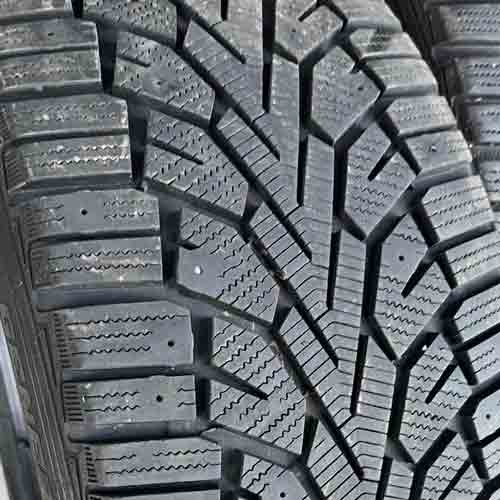The General AltiMAX Arctic 12 is designed for drivers seeking dependable winter traction across diverse conditions. Tailored for a range of vehicles, this tire offers a blend of responsive handling and consistent performance on icy, wet, and snow-covered roads.

Table of Contents
Key Takeaway
So overall, the General Altimax Arctic 12 tire exhibits pretty decent performance across varied conditions.
The tire excels in:
- Ice Traction: Its unique tread pattern with multi-directional biters and angled siping offers excellent grip.
- Snow Traction: The aggressive tread pattern ensures superior snow collection, and its V-shaped central lugs provide impressive snow acceleration.
- Wet Traction: Rapid water evacuation is facilitated by its directional tread pattern and expertly designed contact patch, which together boost hydroplaning resistance and overall wet performance.
While its performance can be improved in:
- Fuel Efficiency: Its considerable weight and design contribute to lower fuel economy compared to its peers.
- Tread Noise: While it’s above average, it is still the loudest in its group.
- Tread Longevity: Despite having a commendable tread depth, its more voided design impacts its overall tread life.
Info on Sizes: The General Altimax Arctic 12 comes in 14 to 19 inches with following. They all have speed ratings of T, while load ratings are available in XL only. Moreover, all sizes have tread depth of 12/32″ and weight range of 16 to 35 lbs.
Tread Appearance
The General Altimax Arctic 12 showcases a blocky, directional tread pattern.

In this design, the central (most) lugs are anchored atop a continuous secondary rubber layer.
These lugs offer multifaceted sides and are abundant with linear sipes.
Their arrow-like shape further complements them with potent in-groove notches.
On the adjacent (to the middle most) ribs, you see notches facing shoulders, and slightly different siping pattern (wave-like, unlike linear slits seen on the central rib).
These shoulder blocks come in pairs, flanked by the broadest (of all) lateral tread voids.
These studable lugs are smoother and less pronounced, showcasing fewer edges and devoid of notches, yet they maintain the wave-like siping.
Internally, the tire features a high-turn-up polyester casing, reinforced by two broad steel belts and a spirally wound nylon cap ply.
Overall Winter Performance
The efficacy of a tire during winter is determined by its performance on ice and snow.
Ice Traction
This measures the tire’s grip on icy surfaces. Due to the slippery nature of ice, the effectiveness of the tire’s rubber compound and tread design becomes paramount.
So ideal tires here should have numerous, flexible “biters” that maintain their functionality even in freezing temperatures.
Having said that, it makes sense why the General Altimax Arctic 12 emerges as a front-runner on icy terrains, compared to other tires in its category.
Its exemplary performance on ice is credited to its unique tread pattern, which blends multi-directional biters with ingeniously angled siping.
Specifically, both its shoulder and the central (most) rib feature a distinct siping design, with variations in width and angular orientation.
This intricate and aggressive siping approach ensures grip from every angle.
Consequently, the tire delivers impressive braking distances and sharp handling precision, translating to an overall above-average performance.
Snow Traction
This evaluates how a tire fares on snow-covered roads. The tire must be able to dig into the snow, make effective snow-to-snow contact, and release snow to avoid accumulation. Snowflakes interlock naturally, so a tire’s tread should capture snow, creating friction that surpasses rubber-to-snow contact.
The General Arctic 12 truly stands out in this aspect, thanks to its aggressive tread pattern which isn’t densely packed.
This design allows the tire to effectively gather snow, leading to exceptional snow collection efficiency.
Additionally, its V-shaped central lugs are adept at shoveling the snow rearward, yielding impressive acceleration in snowy conditions.
For perspective, the Altimax only trails by just under half a foot in acceleration tests when compared to the best performer in this category.
Wet Traction
Tire performance in wet conditions hinges on tread design and rubber composition. These attributes shape wet grip and hydroplaning resistance.
Wet Gripping
Wet grip, akin to its dry counterpart, depends on the rubber’s contact with the road. Water, however, can prevent this contact.
And that’s where grooves and sipes come in.
While grooves eliminate most of the water, sipes address residual water particles. These sipes release air, creating a suction effect that removes water, enabling the tire to maintain road contact.
Now, the General Altimax Arctic 12 does a great job here, employing a very aggressive siping pattern that combines dual wave-like and linear patterns (linear on central rib, while wave-like on adjacent ones).
These multi-angled sipes ensure versatile grip, effectively securing traction in all directions.
However, it’s worth noting that a significant portion of its traction can be attributed to its hydroplaning resistance, though let me elaborate it in the following section.
Side Note: When it comes to winter tires, the Continental VikingContact 7 (review) offers one of the best winter traction. Just an FYI.
Resistance to Hydroplaning
Hydroplaning occurs when water disrupts the connection between the tire and the road. But why this happens? Well water is incompressible, so if it isn’t channeled away, it can come in between, causing a loss of traction.
So it has to be dealt with. And tires do that with grooves (for the most part), which direct water away, mitigating the risk of aquaplaning (or floating of the tire).
Now the General Altimax Arctic 12 excels here, as it escapes water out, pretty quickly and efficiently, allowing for decent overall float speeds.
Its directional tread pattern, characterized by squared-off central lugs, creates voids that run in all directions, facilitating rapid water evacuation.
Additionally, the tire comes with an expertly designed contact patch that applies enhanced pressure on the water, ensuring it is forced out with vigor.
This design technically means that most of the water is effectively channeled out through the grooves, leaving the sipes with minimal/less residual work, thereby enhancing overall wet performance.
Comfort Levels
Tire comfort relates to noise reduction and vibration absorption, influenced by construction, materials, tread pattern, and sidewall design.
Tread Noise
Noise often stems from air colliding with tire tread walls. So to put simply, tires with larger tread gaps produce more noise.
Now, General Altimax Arctic 12 delivers okay performance in this area, standard for a winter tire.
Its more open shoulder voids coupled with its multi-angled siping lead to a bit more audible growl.
However, its performance still stands out as above average, largely due to its variable pitch tread design, which effectively minimizes in-groove resonance.
But yes, it’s still the loudest tire in its group (even though its only by a small difference).
Bumps Absorption
Tires function as a vehicle’s secondary suspension, cushioning against road irregularities. This absorption is a product of both the tire’s internal and external construction.
And here, the General Altimax Arctic 12 is one of the best among its competitors, mainly because of two main things.
One, it’s rubber is relatively softer.
And two, it offers relatively greater tread depth, combined with independent lugs.
This basically allows the bumps energy to be transformed in to the bending of the lugs, thereby mitigating road vibrations efficiently.
Fuel Economy
Tire fuel efficiency correlates with weight and traction, which impact rolling resistance. But how these factors matter here?
Well, put simply, heavier tires with broad tread gaps often flex more during maneuvers, consuming energy otherwise used for tire movement.
Now, the General Altimax Arctic 12, while offering acceptable rolling resistance, falls short in terms of fuel economy when compared to its peers.
This is understandable given the tire’s significant weight and the presence of independent lugs lacking foundational supports.
Additionally, the multitude of in-groove notches and multi-angled biting edges intensify the grip, leading to increased fuel consumption.
So in summary, the fuel efficiency of the Altimax Arctic 12 is somewhat below average for top-tier winter tires.
Dry Performance
Even for winter tires, dry traction is vital. It centers on the rubber’s road contact and divides into directional grip and lateral traction.
Longitudinal Grip
This grip pertains to a tire’s straight-line traction and is predominantly about the central tread’s road contact. As this area bears the most weight when moving straight, its performance influences braking efficiency (direct measure of longitudinal grip).
Among its direct competitors, the General Altimax Arctic 12 falls short by just an average of 2 feet in braking distance compared to the top-performing tire in this category.
The tire’s continuous central rib ensures steady road contact, which in turn contributes to shorter braking distances and faster acceleration during testing.
Dry Handling
Dry handling combines lateral traction and steering feedback. The tire’s lateral grip, indicative of its sideways traction, largely rests on its shoulder lugs. As tires turn, these lugs interact with the road, determining traction quality.
Having said that it can be explained why the General Altimax Arctic 12 offers pretty decent overall handling performance, I mean comparing other tires in it’s winter category.
So how come?
Well, this can be attributed to its stiffer internal nylon cap ply.
This feature ensures the tire’s shoulder remains firm during cornering, enhancing steering responsiveness.
However, its performance might have been further improved with a less voided structure.
Tread Longevity
Tread longevity intertwines with rolling resistance and tread depth. Though greater tread depth extends the tire’s life, it also increases the likelihood of lug bending, resulting in more heat and resistance.
Now although the General Altimax Arctic 12 has a good enough tread depth (which technically should allow the tire to take more time reaching down to 2/32″), the tire only offers average tread life here.
And the main issue is its more voided up design.
So even with the relatively lighter weight, the tire still pushes its lugs down more, as that weight is concentrated on a smaller rubber area.
This increases rolling friction, lowering overall tread longevity. That’s why it makes sense why the tire don’t come with any treadwear warranty.
Conclusion
The General Altimax Arctic 12 proves itself as a decent overall winter tire, showcasing strengths in key areas critical for cold conditions.
Its distinctive tread pattern, featuring multi-directional biters and ingeniously angled siping, allows for exceptional grip on icy terrains, while in snowy conditions, its design facilitates effective snow collection and impressive acceleration, outpacing many competitors.
Wet conditions reveal its rapid water evacuation capabilities, enhancing hydroplaning resistance and maintaining traction.
And talking about dry conditions, its solid central rib enhances braking efficiency and acceleration, though its handling has some room for improvement.
Fuel efficiency, however, is a notable drawback, being below average, attributed to its design and weight, and the same factors also let down it’s longevity too.
Moreover, the tire ensures comfort with adept bumps absorption, though it’s slightly noisier.